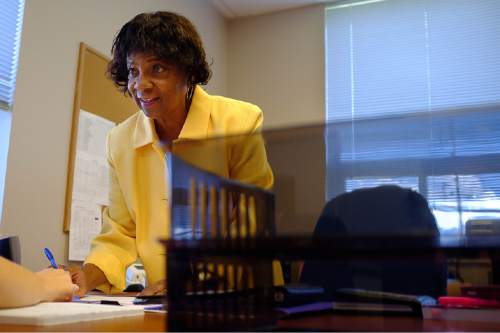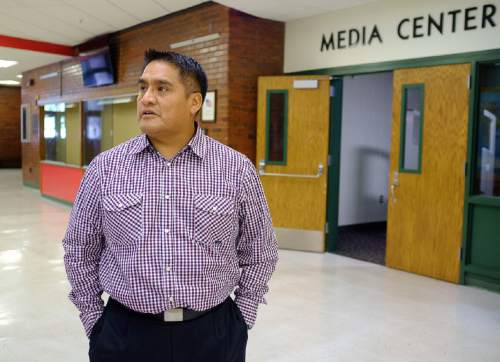This is an archived article that was published on sltrib.com in 2015, and information in the article may be outdated. It is provided only for personal research purposes and may not be reprinted.
Joyce Gray became Utah's first black school principal in 1984 after assuming the top post at Arcadia Elementary.
After three decades in education, the Virginia native believes Utah's educators have become more diverse during the course of her career, but there's still work to be done before Utah schoolteachers reflect Utah's students.
"It's good for [students] to see the diversity so they know they live in a society that is comprised of more than one race," she said. "Not one culture, but many, many ethnicities and many, many cultures."
Gray describes educator diversity in Utah as a "work in progress," and data from the state Office of Education back her up.
In Utah, 1 in 4 public-education students is part of a racial or ethnic minority group.
But their teachers are overwhelmingly white. Out of roughly 31,000 certified teachers and principals, 89 percent self-identify as Caucasian.
That leaves just one in 10 educators who are either racially diverse or who declined to indicate a racial identity as part of their certification.
The gap is largest for Utah Latinos, who make up 16 percent of public school students but only 2.1 percent of teachers and principals.
Bryant Middle School Principal and native Peruvian James Yapias said it's important for students to have role models in the school system. A diverse faculty, he said, pairs students with educators who look or speak like they do. But highly qualified teachers can make an impact on students regardless of their race.
"What matters is the instruction — the quality of instruction," Yapias said. "We hire the best for the school and for the student needs."
State education managers blame the disparity between teacher and student demographics to the rapid diversification of Utah's population in recent years.
It takes time, the logic goes, for those trends to filter through the school system and university education programs to produce a diverse crop of new teachers. More than 970 minority students were pursuing teaching degrees at Utah colleges and universities during the 2012-2013 school year.
A decline in the teaching profession also could be to blame for the gap, according to Deputy State Superintendent Sydnee Dickson. When fewer people see education as a viable career choice, she said, it's that much more difficult to recruit a diverse pool of teaching candidates.
"We're experiencing a teacher shortage on all fronts," she said. "Within that shortage, we're less likely to have teachers of color than if we had a robust teaching workforce."
Teachers also are subject to strict employment requirements, which can be a barrier to immigrants, even those who worked as educators in their native countries.
Evelyn Cabrera-Lopez moved from Guatemala to Utah in 2006 and worked in data entry until she got a job with the Davis School District in 2009.
"As soon as you come to the country, you need to start working," she said. "There are bills to pay."
Cabrera-Lopez works as a computer lab manager at Foxboro Elementary, a position that does not require a full teaching certification. She is working to complete her credentials and said the Davis School District is proactive about helping faculty members advance their careers. But for many people, she said, the time and effort required to teach in Utah are not worth the salaries that school districts pay.
"We could have more diversity, but teachers are not getting paid enough," Cabrera-Lopez said, "so not a lot of people want to do it."
Michelle Smith, a mixed-race English teacher at Viewmont High, said there is likely a correlation between the diversity of Utah educators and the diversity of The Church of Jesus Christ of Latter-day Saints. Teachers of color are less likely to be Mormon and, as a result, are less likely to move to Utah for low-paying school jobs.
"There's not a lot of draw," she said. "Communities [in Utah] certainly appreciate LDS people and faculty members."
While teacher diversity is preferred, Smith said it's not critical for student success. She grew up in Wyoming and said attending mostly white schools didn't impede her academic progress.
"The lack of diversity, as far as teaching me," she said, "didn't prevent me from being a successful person."
Salt Lake Teachers Association President Susan McFarland said a school faculty can only be as diverse as the people who want to work there.
"We don't have much to choose from," she said. "There's not a lot coming for jobs in our district."
Schools would benefit from greater diversity, McFarland said, and it's "wonderful" for students to see their own race reflected in the teachers' lounge. But until Utah is more attractive for prospective teachers, she said, schools will continue with a narrow pool from which to draw.
"We really need to reach outside the state," she said.
Diversity in Schools
Utah student diversity*
White • 75.9 percent
Latino • 16.3 percent
Two or more races • 2.2 percent
Asian • 1.7 percent
Pacific Islander • 1.5 percent
Black • 1.3 percent
American Indian • 1.1 percent
Teacher and principal diversity*
White • 89.8 percent
Unknown • 5.9 percent
Latino • 2.1 percent
Asian • 1.2 percent
American Indian • 0.4 percent
Black • 0.3 percent
Pacific Islander • 0.3 percent
*Based on fall 2014 enrollment and current teacher certifications. Numbers are rounded.
Source: Utah State Office of Education





